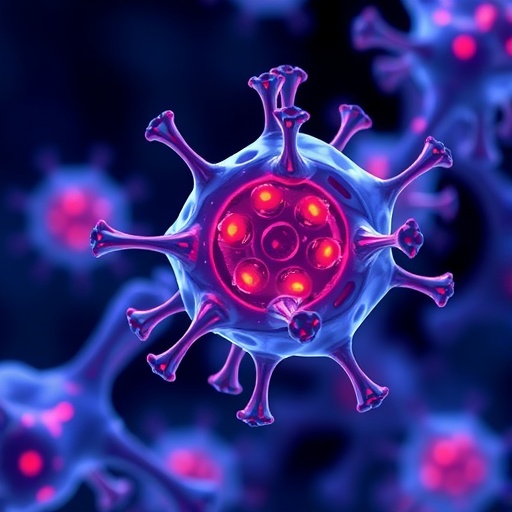
Credit: Texas A&M University
Leading a double life as both solids and liquids, liquid crystals occupy center stage for creating smaller, faster and more efficient technologies. Even at the level of single particles, liquid crystals can bend light and react to external forces, like electric fields or physical pushes and pulls. And so, a tiny quantity of liquid crystals is usually enough to achieve high performance in many applications, ranging from monitor screens to solar panels.
But in order to fully tap into a liquid crystal’s wondrous properties, its constituent particles must be systematically assembled.
In a new study, Texas A&M University researchers have discovered that applying a small difference in temperature to a watered-down mixture of a compound called zirconium phosphate initiates its liquid crystallization. As zirconium phosphate particles move toward warmer temperatures, they start aligning themselves with each other and eventually turn into pure liquid crystals, the researchers said.
“Ours is the first proof-of-concept study to show that temperature gradient is an effective, yet simple, tool to assemble high-quality liquid crystals,” said Dr. Zhengdong Cheng, professor in the Artie McFerrin Department of Chemical Engineering. “Also, our results indicate that we can move liquid crystals by just varying temperature, a property that can potentially be used to transport liquid crystal particles from one place to another, thus paving the way for applications beyond those that are commonly associated with liquid crystals today.”
The researchers reported their findings in the October issue of the journal ACS Nano.
Liquid crystals represent a state of matter that lie somewhere between solids and liquids. Like molecules in solids that form crystals, those in liquid crystals are arranged in a semi-systematic fashion, like cars in a partly-full parking lot. But liquid crystals are also runny and can assume any shape like liquids. Furthermore, in their liquid crystal avatar, materials often show exotic properties. For example, they split up light beams or change their molecular alignments in response to electric fields.
But whether or not a material can assume a liquid crystal state depends on the overall shape of their constituent particles. Substances made up of spherical particles do not form liquid crystals. On the other hand, materials consisting of particles that are elongated like rods or flat like discs do form liquid crystals. Cheng and his team were particularly interested in zirconium phosphate because its disc-like particles have the ability to self-assemble into larger, flat 2D structures in their liquid crystalline state.
“Many particles found in nature, like red blood cells, nucleosomes and clay particles, are disc shaped and under the right circumstances, they can self-assemble into liquid crystals,” said Cheng. “So, we used zirconium phosphate as a proxy to investigate if there is a way to experimentally control the liquid crystallization of these particles.”
Zirconium phosphate has been shown to assemble into liquid crystals on its own if large enough quantities are added to water. But the resulting liquid crystals often have defects and are unstable. So, Cheng and his team came up with an alternative approach.
Cheng had shown previously that applying a temperature difference could make spherical particles assemble into clumps of crystals. Using the same principle, his team investigated if varying temperatures could be used to assemble zirconium phosphate into liquid crystals.
For their experiments, the Texas A&M team made a mixture of zirconium phosphate and water and filled it into thin, two-inch-long tubes, making sure that the quantity of zirconium phosphate was small enough to not trigger automatic liquid crystallization. Next, they applied heat in such a way that the temperature difference between either ends of the tube was around 10 degrees.
Within an hour, Cheng and his team found that the zirconium phosphate particles in the cooler end of the tube began to creep toward the warmer end, triggering liquid crystallization from the tube’s warmer end.
“Just like water in a boiling pot circulates from the bottom where it is hot to the top of the container where it’s cold, water in our tubes was also circulating from warmer to cooler temperatures,” said Dali Huang, graduate student in the Texas A&M College of Engineering and a primary author of the study. “Accordingly, the zirconium phosphate particles also moved in the direction of the water flow and arranged themselves into liquid crystals. “The researchers speculated that the push from the flowing water helps zirconium phosphate particles to position themselves systematically until they form liquid crystals. Also, they found that the liquid crystals created with temperature gradients were less defective than those formed by other methods.
Cheng noted that their findings open new doors for use in a variety of contexts.
“By virtue of their shape, disc-shaped particles have a larger surface area compared to their volume,” said Cheng. “If we think of the next generation of biomedical devices, for example, we can potentially take advantage of this geometry to load medicinal particles on their flat surfaces and then vary temperature to transport them to target a specific part of the body.”
###
Other contributors to the research include Dr. Abhijeet Shinde, Dali Huang, Mariela Saldivar, Hongfei Xu, Dr. Minxiang Zeng, Ugochukwu Okeibunor, Dr. Ling Wang, Carlos Mejia, Sasha George and Dr. Lecheng Zhang from the Texas A&M Department of Chemical Engineering; and Dr. Padetha Tin from the NASA Glenn Research Center, Ohio.
Media Contact
Amy Halbert
[email protected]
979-458-4243
Original Source
https:/
Related Journal Article
http://dx.





